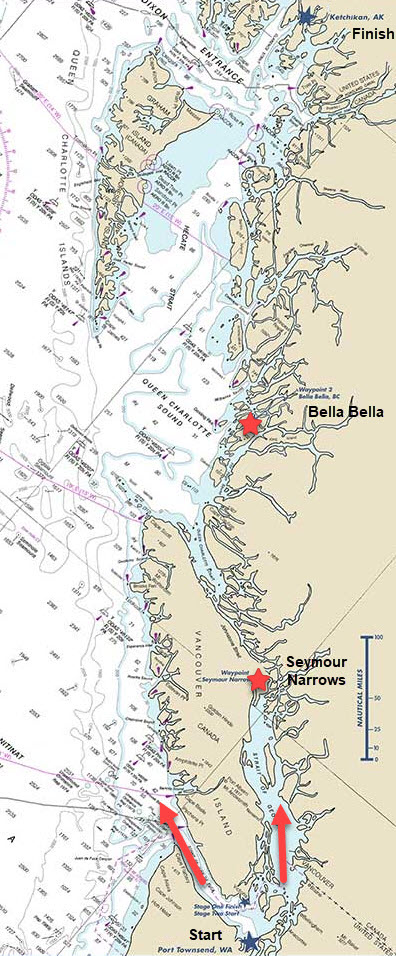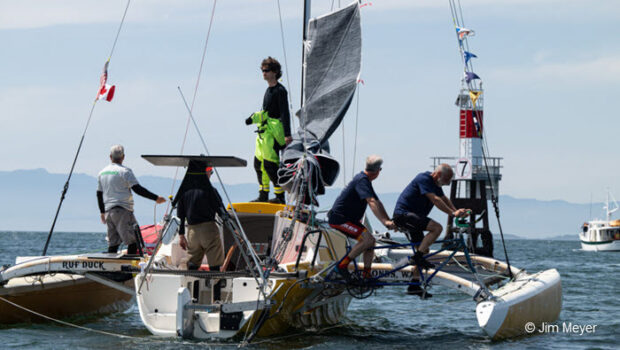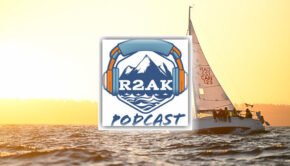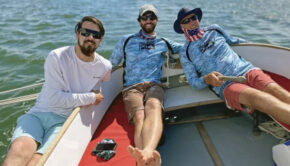R2AK: Raciest race we’ve seen in years
Published on June 9th, 2023
The 7th edition of the 750 mile Race to Alaska (R2AK) began June 5 with a 40-mile “proving stage” from Port Townsend, WA to Victoria, BC. For those that finished within 36 hours, they were allowed to start the remaining 710 miles on June 8 to Ketchikan, AK. Here’s the Stage 2/Day 2 report:
Anyone who’s ever gotten married, taken the SATs, or gone to court knows that there is a big difference between the night before and the morning of. The night before there is a sleep buffer between you and the big uncertain. Day of? It’s right there, clock ticking louder and louder until it all of a sudden your whole life changes. Race to Alaska start day has all of the trappings of at least two of those, with a chance of drowning.
The energy on the docks early on start day was noticeably different than the community barbecue vibes of the night before when crews made food, mingled with the public, and even ended up on the evening news as the subject of a magic trick (we can’t make this stuff up).
The day before was laid back, the hours before teams checked and rechecked things they had checked and rechecked 100 times before—the R2AK equivalent of patting your pockets for your plane ticket you know is there. It’s still there, but that doesn’t mean you won’t pat your pocket 18 more times between security and your gate.
It wasn’t all anxiety driven pants patting; some teams had pressing issues in process. Team Tres Equis was swapping out belt for chain on their pedal drive and finishing up a repair to a cracked bulkhead. For those of you not fluent in “boat,” a bulkhead is a wall-ish thing that not only holds up the ceiling, but in this particular case also is engineered to be the main structure that transfer two particular types of forces while sailing:
• The force that comes from the top of the mast pulling up on the wires (“shrouds”) that keep it from blowing over when the sail is up.
• The force that happens when the pontoon-y thing (“ama”) is pushed into the water as the boat leans over away from the wind (“heels to leeward”)
A cracked bulkhead means that either the shrouds could pull themselves out of the boat, careening the mast into the sea, or that the ama could buckle the boat’s entire structure. Neither optimal outcomes, especially for a boat they had owned for less than a month. They found some aluminum T-squares and some JB Weld style two-part epoxy, mashed it all together in a repair, said a prayer, drank a beer, and crossed their fingers.
For them and everyone else, years, months, and days of preparation turned to minutes. The last of which broke down something like this:
11:30: At least one team was seen hustling back to the marina from the outdoor store. Running, boxes in hand to throw the boxes onboard before the start.
11:45: R2AK volunteers cleared the docks, loved ones gave last hugs, and a racer gave a last long snuggle to his new baby, long enough that a news photographer asked “Is that baby going to Alaska?”
11:50: Racers gathered at the top of the sea wall, in the most costumed version that this spectacle had ever seen. Team Ship of Fools were adorned by their jester-inspired golf shirts, and in an unwanted display of immodesty Team Dacron and Denim and Team Budgie Smugglers lived up to their names with faux denim and monogrammed speedos respectfully. Team Toybox Express rocked the other end of the bedroom modesty spectrum with matching checkered long legged/long sleeved pajamas bearing paw prints and the words “Bear Cheeks” on their judiciously buttoned butt flaps. At least one person was heard asking the obvious: “Can the speedo people and pajama boys trade outfits?”
11:55: Jesse Wiegle offered a classic Race Boss affirmation speech “You are racing to challenge yourselves to do something incredible, and because of that you are inspiring the world.”
11:58: Race Boss learns that his air horn to signal the start is faulty, pressed a boat in the harbor into service for its signal cannon and Team Hornblower for his horn.
11:59: Oddly a man with a phone in one hand and a chocolate dipped soft serve cone in the other wandered into the racer scrum looking for someone “Where are you?” he shouted annoyed into his phone, somehow not noticing the hundred people in orange hats and/or speedos that surrounded him.
11:59.95: Countdown. 5…4…3…2…1
12:00: The airhorn sputtered, Hornblower’s signature horn blew true and clear, cannons fired, and the throng of thongs (and thankfully more dressed in thankfully more) ran down pell mell, cast off and pedaled, paddled, and rowed their way out of the harbor to the cheers of more than a thousand that lined the harbor to be a part of the spectacle of the most simultaneously inspiring and hilarious start to a boat race that we have ever had a hand in creating. It was a moment of humanity that was all at once complicated, celebratory, and madcap beautiful; the 700+ miles of unknown that was underway.
What happened next was a series of R2AK firsts:
1. There was wind, and plenty of it, for a while. Most years teams are rewarded for muscling out of the harbor with flat calm and the need for more muscle once they reached the harbor mouth. This year the teams cleared Victoria’s Harbor’s no sail zone, raised their sales and were off—and they flew. The fast of the fleet posted speeds that poked over 15 knots before making the turn north at Trial Island.
2. The tide turned in their favor, for a long while. All up Haro Strait and into the Strait of Georgia, even though the wind died the teams were headed in the right direction on tide alone.
3. No one went on the outside route. And thank god for that. The weather forecast looked like molten garbage: 40 knot winds and waves that were born in Japan then took the whole width of the Pacific to hone their brutality. For days. Five teams were cleared for the outside, and all of them decided not to. As one racer put it: “I can make good decisions, too.”
4. The wind was going in the right direction. From race start until even past midnight, the wind was going in the same direction of the race. Teams ate up the miles and big pretty sails (“spinnakers”) were the order of the day.
5. After an initial period of predictable flubbery, all the trackers worked, in unison, for hours (Good job Shane in New Zealand).
By 1pm we had too much good news. This is an adventure race, dammit, it’s supposed to be hard, not this mamby pamby, sailing downwind on following tide, with the sun shining while wearing Speedos sort of affair. Especially after Stage 1’s cake walk and animated birds, if this kept up we were worried they were going to revoke our membership at the Royal Adventure Race Society, tear the sleeves from our jacket and punch out our top hat. Lucky/unlucky, we had another first:
6. A team tapped out, then rejoined in less than four hours: While we were worried about their bulkhead, we didn’t know that Team Tres Equis also had rudder issues. Two hours in they called and said they were going to tap out. Just too much too early. They headed to Roche Harbor for what we thought was an act of resort infused consolation. Unclear if it was a referendum on the resort, but two hours later they called again and said they were good to go. We take great pride that we have refrained from calling them “Team Dos Break-ies”. See, those self-help books are working.
After the early romp of the start, by the time the teams made it halfway up Haro Strait the weather laid down and divided itself into fingers of wind that fingered their way through the San Juan and Gulf Islands, anointing some teams and denying others.
The lead pack split into three strategies: the fast trimarans that sailed into narrow channels before popping out into the Strait of Georgia, the more standard approach of boats that stayed the eastern route of bigger water of Boundary Pass for the hopes of clean air, and the ‘hold my beer,’ never-been-seen-before WAY eastern approach of Team Bonesaw whose theory appeared to be that an investment of 30 miles the wrong direction would pay off in the end.
Seeing steady wind in the forecast they wagered on the longshot of Rosario Strait then never got their chips back. As of 0600 on Friday they trailed the leaders by some margin, but currently are way ahead on originality.
It’s hard to talk about yesterday without marveling about the human anomaly that is Team Pestou, so named for the sole sailor aboard: Eric Pesty. One of R2AK media armada caught up with him as he rode the tide out of Active Pass. At the time he was leading Ruf Duck and Mojo sailing a theoretically slower boat by himself.
He took 15 minutes off of flying the spinnaker to hang out of the trampoline (“meshy bit between the pontoony thing and the main boat”) to talk to us. Read that again: no one was steering, trimming sails, navigating, anything. No one was sailing, his spinnaker was flying, and he was winning. Seeing him sail (or not sail) was the closest thing to Jedi level anything that we’ve ever seen.
Common wisdom says that solo teams can’t win because eventually they have to pull over and sleep. Smashing that expectation, his plan for the night was to keep sailing while he slept. Just let the boat keep sailing itself, and while his lightsaber might have sputtered a bit, it looks like it worked. Morning finds him no longer first but still in contention. The force is strong in this one.
Farther back the human powered fleet have gammed up in the Gulf Islands, except for Lillian who decided to start a day late but take her tracker to a wedding she was attending on Hood Canal. Don’t worry, it wasn’t hers. Sad news from the human fleet this morning, veteran R2AK racer and all around nice guy Team Zen Again Dog is hurt and out. Unpacking his kayak while setting up camp, a big boat wake lifted his kayak onto his arm and injured it. He’s going to get it checked out but he’s done for the race. Dammit.
This morning there are seven teams in contention and within striking distance of Seymour Narrows. Speedos notwithstanding, so far this is the raciest race we’ve seen in years.
Race details – Entry list – Tracker – Facebook
 The 7th edition of the Race to Alaska in 2023 will follow the same general rules which launched this madness in 2015. No motor, no support, through wild frontier, navigating by sail or peddle/paddle (but at some point both) the 750 cold water miles from Port Townsend, Washington to Ketchikan, Alaska.
The 7th edition of the Race to Alaska in 2023 will follow the same general rules which launched this madness in 2015. No motor, no support, through wild frontier, navigating by sail or peddle/paddle (but at some point both) the 750 cold water miles from Port Townsend, Washington to Ketchikan, Alaska.
To save people from themselves, and possibly fulfill event insurance coverage requirements, the distance is divided into two stages. Anyone that completes the 40-mile crossing from Port Townsend to Victoria, BC can pass Go and proceed. Those that fail Stage 1 go to R2AK Jail. Their race is done. Here is the 2023 plan:
Stage 1 Race start: June 5 – Port Townsend, Washington
Stage 2 Race start: June 8 – Victoria, BC
While the Stage 1 course is simple enough, the route to Ketchikan is less so. Other than a waypoint at Bella Bella, there is no official course. Whereas previous races mandated an inside passage of Vancouver Island via Seymour Narrows, the gloves came off in 2022. For teams that can prove their seaworthiness, they now had the option of the western route.
There is $10,000 if you finish first, a set of steak knives if you’re second. Cathartic elation if you can simply complete the course. R2AK is a self-supported race with no supply drops and no safety net. Any boat without an engine can enter.
There were no races in 2020 and 2021 due to the pandemic. In 2022, there were 45 starters for Stage 1 and 34 finishers. Of those finishers, 32 took on Stage 2 of which 19 made it to Ketchikan.
Source: R2AK







 We’ll keep your information safe.
We’ll keep your information safe.